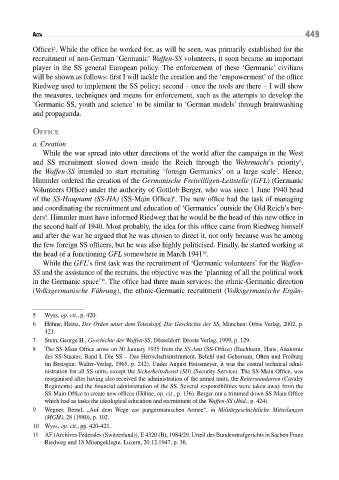Page 449 - Conflitti Militari e Popolazioni Civili - Tomo I
P. 449
449
aCta
Office) . While the office he worked for, as will be seen, was primarily established for the
5
recruitment of non-German ‘Germanic’ Waffen-SS volunteers, it soon became an important
player in the SS general European policy. The enforcement of these ‘Germanic’ civilians
will be shown as follows: first I will tackle the creation and the ‘empowerment’ of the office
Riedweg used to implement the SS policy; second – once the tools are there – I will show
the measures, techniques and means for enforcement, such as the attempts to develop the
‘Germanic SS, youth and science’ to be similar to ‘German models’ through brainwashing
and propaganda.
Office
a. Creation
While the war spread into other directions of the world after the campaign in the West
and SS recruitment slowed down inside the Reich through the Wehrmacht’s priority ,
6
the Waffen-SS intended to start recruiting ‘foreign Germanics’ on a large scale . Hence,
7
Himmler ordered the creation of the Germanische Freiwilligen-Leitstelle (GFL) (Germanic
Volunteers Office) under the authority of Gottlob Berger, who was since 1 June 1940 head
of the SS-Hauptamt (SS-HA) (SS-Main Office) . The new office had the task of managing
8
and coordinating the recruitment and education of ‘Germanics’ outside the Old Reich’s bor-
ders . Himmler must have informed Riedweg that he would be the head of this new office in
9
the second half of 1940. Most probably, the idea for this office came from Riedweg himself
and after the war he argued that he was chosen to direct it, not only because was he among
the few foreign SS officers, but he was also highly politicised. Finally, he started working at
the head of a functioning GFL somewhere in March 1941 .
10
While the GFL’s first task was the recruitment of ‘Germanic volunteers’ for the Waffen-
SS and the assistance of the recruits, the objective was the ‘planning of all the political work
in the Germanic space’ . The office had three main services: the ethnic-Germanic direction
11
(Volksgermanische Führung), the ethnic-Germanic recruitment (Volksgermanische Ergän-
5 Wyss, op. cit., p. 420.
6 Höhne, Heinz, Der Orden unter dem Totenkopf, Die Geschichte der SS, München: Orbis Verlag, 2002, p.
421.
7 Stein, George H., Geschichte der Waffen-SS, Düsseldorf: Droste Verlag, 1999, p. 129.
8 The SS-Main Office arose on 30 January 1935 from the SS-Amt (SS-Office) (Buchheim, Hans, Anatomie
des SS-Staates, Band I, Die SS – Das Herrschaftsinstrument, Befehl und Gehorsam, Olten und Freiburg
im Breisgau: Walter-Verlag, 1965, p. 242). Under August Heissmeyer, it was the central technical admi-
nistration for all SS units, except the Sicherheitsdienst (SD) (Security Service). The SS-Main Office, was
reorganised after having also received the administration of the armed units, the Reiterstandarten (Cavalry
Regiments) and the financial administration of the SS. Several responsibilities were taken away from the
SS-Main Office to create new offices (Höhne, op. cit., p. 136). Berger ran a trimmed down SS-Main Office
which had as tasks the ideological education and recruitment of the Waffen-SS (Ibid., p. 424).
9 Wegner, Bernd, „Auf dem Wege zur pangermanischen Armee“, in Militärgeschichtliche Mitteilungen
(MGM), 28 (1980), p. 102.
10 Wyss, op. cit., pp. 420-421.
11 AF (Archives Fédérales (Switzerland)), E 4320 (B), 1984/29, Urteil des Bundesstrafgerichts in Sachen Franz
Riedweg und 18 Mitangeklagte, Luzern, 20.12.1947, p. 36.

